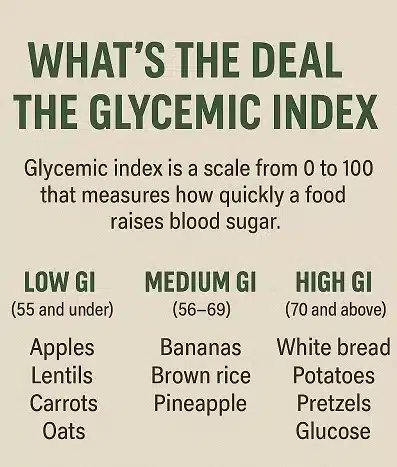Let’s talk about glycemic index—the food label stat most people ignore, misunderstand, or associate with restrictive diets from the early 2000s. But here’s the thing: if you care about energy, fat loss, brain clarity, or avoiding that post-lunch nap attack, the glycemic index (GI) is exactly the kind of thing you should be paying attention to.
No, it’s not about fear-mongering carbs or counting numbers like you’re doing math homework. It’s about learning how different foods actually affect your body, especially your blood sugar and insulin levels. Because once you understand GI, you can make smarter food choices without obsessing over calories—or cutting out everything that tastes good.
So, What Is Glycemic Index?
-
Foods with a high GI (70 or above) spike blood sugar fast—think white bread, glucose syrup, or cornflakes.
-
Medium GI (56–69) includes things like bananas, couscous, and sweet potatoes.
-
Low GI (55 and under) covers most fruits, legumes, whole oats, and non-starchy vegetables.
Pure glucose is the baseline at 100. Everything else gets ranked in comparison. The faster a food dumps sugar into your bloodstream, the higher its GI score.
Why It Matters
When your blood sugar spikes, your pancreas releases insulin—your body’s glucose traffic cop. Insulin helps shuttle that sugar into cells to be used for energy or stored as fat. That’s normal. But do it too often, and you start running into problems:
-
Crashes and energy slumps
-
Brain fog and poor concentration
-
Constant hunger
-
Fat gain (especially belly fat)
-
Long-term issues like insulin resistance and type 2 diabetes
A diet consistently full of high-GI foods turns your metabolism into a rollercoaster—up fast, crash hard, repeat. You’re always hungry, always tired, and always wondering why that “healthy” smoothie made you feel worse 30 minutes later.
Not All Carbs Are the Enemy
Let’s be clear—I’m not saying carbs are bad. I’m saying context matters. You can still eat fruit, root vegetables, and even the occasional grain if they work for you. What matters is how fast and how hard those carbs hit your bloodstream—and what you pair them with.
For example, a bowl of white rice has a high GI. But add avocado, grilled salmon, and some greens? Boom—fat, protein, and fiber slow down digestion and blunt that blood sugar spike. The GI becomes more of a guideline than a rule, because meals are more than one ingredient.
What About Glycemic Load?
Glad you asked. Glycemic load (GL) goes one step further and takes into account the quantity of carbs in a typical serving. It’s a more accurate real-world number. Watermelon, for example, has a high GI—but it’s mostly water. So its glycemic load is low. You can still enjoy it without nuking your blood sugar.
How to Eat Smarter Without Overthinking It
-
Prioritize low-GI foods like berries, leafy greens, legumes, and most nuts
-
Pair carbs with fat, fiber, or protein—never eat naked carbs
-
Watch your portion sizes for high-GI foods like white potatoes or white rice
-
Look for functional swaps: use lemon or vinegar to lower a meal’s GI, or choose agave powder over sugar for a slower burn
-
Use your body as a test lab—energy crashes, cravings, or fog are red flags your blood sugar’s off
Glycemic index isn’t just some obscure nutrition metric. It’s a window into how your body responds to what you eat. Once you understand it, you don’t have to fear carbs—you just have to use them strategically. Eat to fuel, not to crash.
Stay motivated.

